
Paul Caplat
Researcher

Farmland birds occupying forest clear-cuts respond to both local and landscape features
Author
Summary, in English
Agricultural landscapes have changed fast in Europe, which has led to steep declines in farmland biodiversity. While this has differentially impacted “farmland species”, some of these seem to be able to use alternative man-made open habitats in forests, such as forest clear-cuts and powerline rights-of-way. We investigated the use of clear-cuts by two historically declining farmland birds, the Yellowhammer (Emberiza citrinella) and the Red-backed Shrike (Lanius collurio), to determine both local and landscape habitat characteristics of clear-cuts used for breeding. Among 101 clear-cuts visited in Scania, southern Sweden, 27% were occupied by Yellowhammers and 12% by Red-backed Shrikes. Yellowhammer occurrence in clear-cuts was positively related to local spruce cover (the planted tree species). There was also an interaction between clear-cut size and the proportion of farmland in the landscape, such that the positive effect of the proportion of farmland nearby was stronger for larger clear-cuts. Red-backed Shrike occurrence was positively related to clear-cut size and the local presence of piles of forest residues (tops and branches). The relation between occurrence and the proportion of clear-cuts in the landscape was positive for small clear-cuts and negative for larger ones. Yellowhammers and Red-backed shrikes are affected by both the local habitat structure in the clearcut and on the composition of the surrounding landscape, most likely because they use the clear-cut for nesting and the surroundings as complementary feeding habitat. To what extent clear-cuts as complementary breeding habitat to farmland may contribute to the conservation of Yellowhammers and Red-backed shrikes, as well as other farmland birds, is a promising path for future investigations.
Department/s
- Biodiversity
- Dept of Physical Geography and Ecosystem Science
- BECC: Biodiversity and Ecosystem services in a Changing Climate
- Centre for Environmental and Climate Science (CEC)
- Biodiversity and Conservation Science
Publishing year
2020
Language
English
Publication/Series
Forest Ecology and Management
Volume
478
Document type
Journal article
Publisher
Elsevier
Topic
- Ecology
Keywords
- Emberiza citrinella
- Farmland bird
- Forestry
- Habitat selection
- Lanius collurio
Status
Published
Research group
- Biodiversity and Conservation Science
ISBN/ISSN/Other
- ISSN: 0378-1127